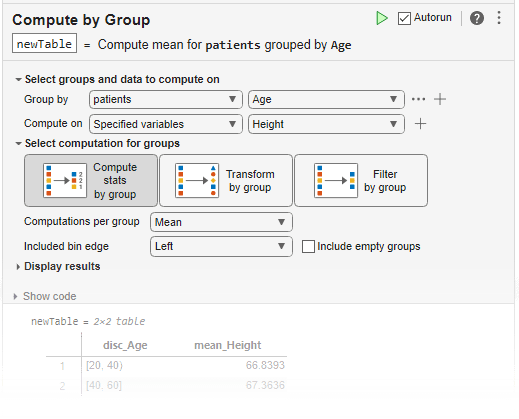groupsummary
Group summary computations
Syntax
Description
Table Data
G = groupsummary(T,groupvars)T. Groups are defined by
rows in the variables in groupvars that have the same unique
combination of values. Each row of the output table corresponds to one group.
For example, G = groupsummary(T,"HealthStatus") returns a
table with the count of each group in the variable
HealthStatus.
You can use groupsummary functionality interactively by
adding the Compute by
Group task to a live script.
For more information, see Group Summary Computation.
G = groupsummary(T,groupvars,method)method and
appends the computation results to the output table as additional variables. For
example, G = groupsummary(T,"Location","median") returns the
median value of every nongrouping variable in T for each
location, in addition to the number of members in each location group.
G = groupsummary(___,Name,Value)G =
groupsummary(T,"Category1","IncludeMissingGroups",false) excludes
the group made from missing data of type categorical
indicated by <undefined> in
Category1.
Array Data
B = groupsummary(A,groupvars,method)method to unique groups in vector, matrix, or cell array
A. Groups are defined by rows in the column vectors in
groupvars that have the same unique combination of
values. Each row of the output array contains the computation results for one
group.
You can use groupsummary functionality interactively by
adding the Compute by
Group task to a live script.
B = groupsummary(___,Name,Value)
Examples
Input Arguments
Name-Value Arguments
Output Arguments
More About
Tips
When making many calls to
groupsummary, consider converting grouping variables to typecategoricalorlogicalwhen possible for improved performance. For example, if you have a string array grouping variable (such asHealthStatuswith elements"Poor","Fair","Good", and"Excellent"), you can convert it to a categorical variable using the commandcategorical(HealthStatus).The
groupsummaryfunction computes one-dimensional summary statistics. To compute grouped summaries in two dimensions, consider using thepivotfunction.
Alternative Functionality
Live Editor Task
You can use groupsummary functionality interactively by adding
the Compute by
Group task to a live script.

Extended Capabilities
Version History
Introduced in R2018aSee Also
Functions
pivot|grouptransform|groupfilter|groupcounts|summary|findgroups|splitapply|discretize|varfun|rowfun|convertvars|vartype|numunique